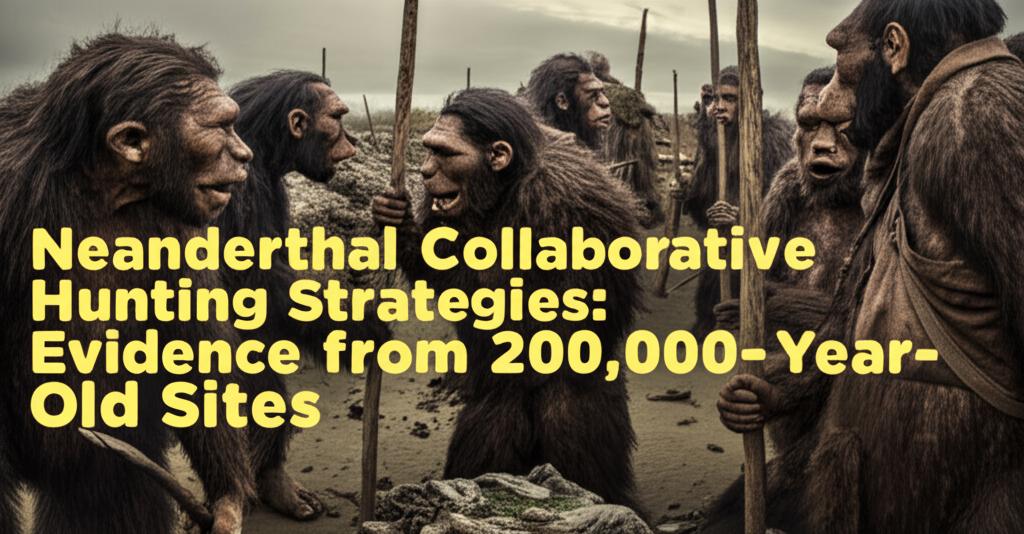Recent archaeological findings from a site in Schöningen, Germany, have provided compelling new evidence suggesting that Neanderthals employed sophisticated collaborative hunting strategies as early as 200,000 years ago. This research, centered on the re-dating of exquisitely preserved wooden spears and animal remains, pushes back the timeline for such complex behaviors in Neanderthals and offers a deeper understanding of their capabilities.
The Schöningen site, initially excavated in the 1990s, yielded a remarkable collection of wooden hunting weapons, including nine complete spears, a lance, and throwing sticks. Alongside these artifacts were the butchered remains of more than 50 wild horses. Original estimates placed the age of these finds at around 300,000 to 400,000 years old, potentially attributing them to Homo heidelbergensis, an earlier human ancestor. However, a new study utilizing advanced dating techniques, specifically analyzing amino acids in fossilized snail shells and horse teeth from the same sediment layer as the spears, has revised this estimate to approximately 200,000 years ago.
This revised dating is significant because it firmly places the creation and use of these weapons within the era of Neanderthals. The craftsmanship of the spruce and pine spears indicates a high level of woodworking skill and cognitive abilities, including long-term planning and coordination.
The layout of the Schöningen site and the concentration of horse remains suggest a strategic and cooperative hunting method. Researchers propose that Neanderthal groups worked together to herd entire family groups of horses towards the ancient lakeshore, where the animals would have been easier to ambush and kill. This type of coordinated hunt would have necessitated effective communication, planning, and a shared understanding of objectives and risks among the group members. The targeting of entire horse family groups implies routine success in these collaborative endeavors.
These findings contribute to a growing body of evidence that challenges older portrayals of Neanderthals as less sophisticated than early Homo sapiens. The ability to organize and execute complex, cooperative hunts for large and dangerous prey suggests a level of social organization and cognitive function comparable to that of early modern humans. Around 200,000 years ago, it appears Neanderthals were developing new ways of cooperating, not only for hunting but potentially for other complex social behaviors.
This new understanding of Neanderthal behavior at Schöningen aligns with findings from other European sites, albeit some younger, where evidence points to Neanderthals teaming up to hunt bison, wild cattle, rhinos, and reindeer. For example, at a site in Neumark-Nord, Germany, evidence dating to about 120,000 years ago suggests Neanderthals used spears for close-range thrusting to kill fallow deer, indicating an ability to hunt in forested environments which would also require complex strategies and cooperation. Further research at Neumark-Nord, focusing on remains from 125,000 years ago, revealed that Neanderthals hunted and butchered massive straight-tusked elephants, animals significantly larger than woolly mammoths. The scale of processing these elephants suggests that Neanderthals may have lived in larger groups than previously thought, or possessed sophisticated methods for food preservation and storage.
While some researchers urge caution, noting that the evolutionary line between late Homo heidelbergensis and early Neanderthals can be blurry, the Schöningen evidence strongly suggests an intensification of cooperative behavior among Neanderthals around the 200,000-year mark. This period may represent a significant shift in how Neanderthals organized themselves socially and interacted with their environment, pooling risk and resources for greater success.
In essence, the evidence from Schöningen and other sites paints a picture of Neanderthals as intelligent, adaptable, and socially complex hominins who were highly skilled hunters, capable of sophisticated collaborative strategies to secure their sustenance. These findings continue to reshape our understanding of our closest extinct relatives and highlight the diverse capabilities that existed within the human family tree.

